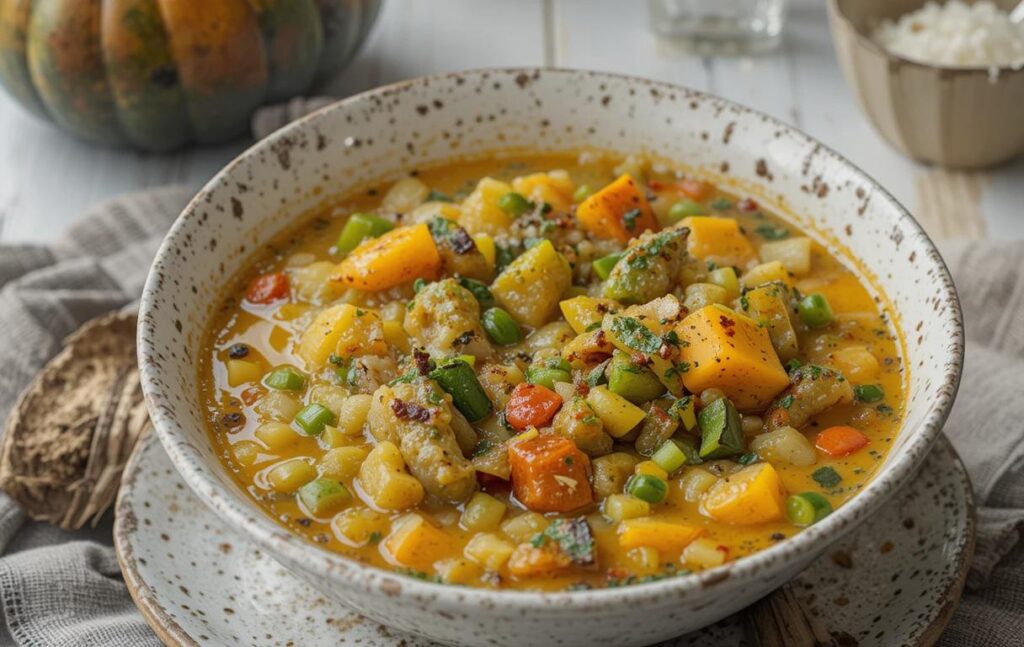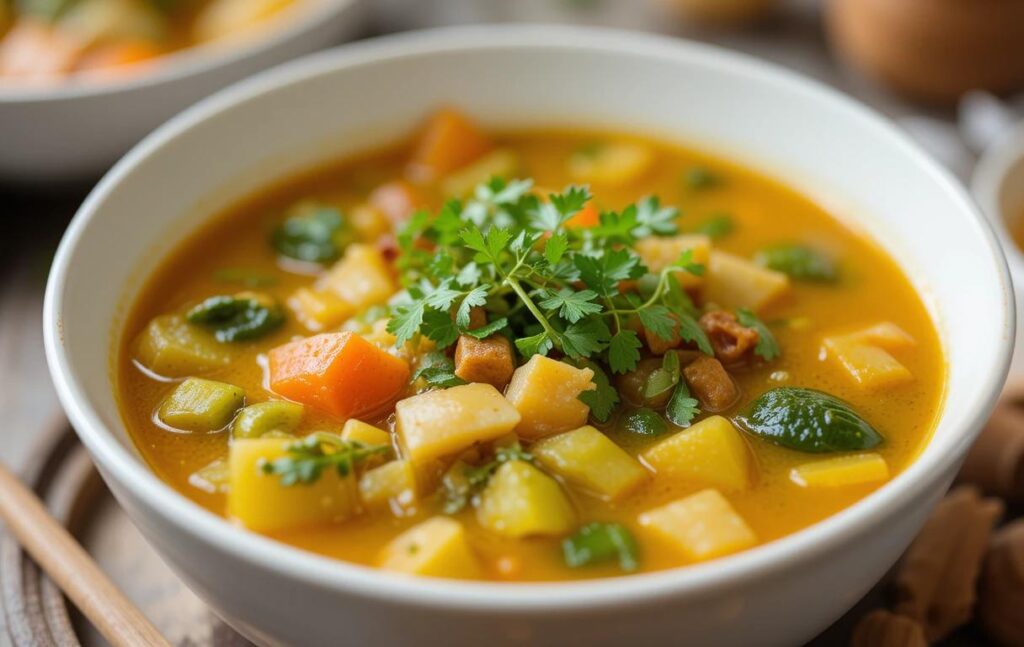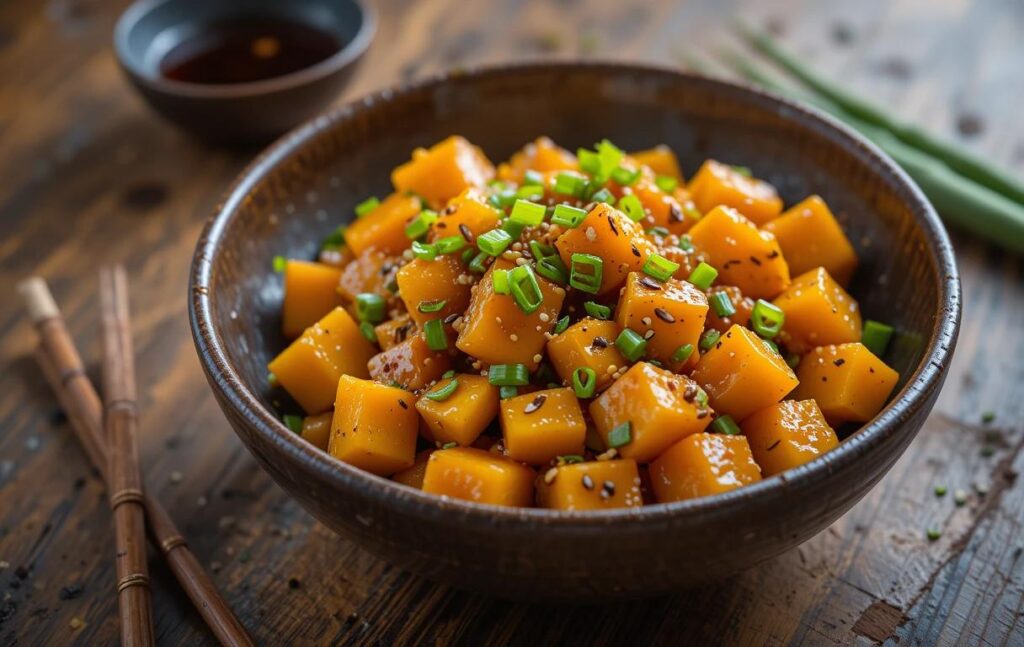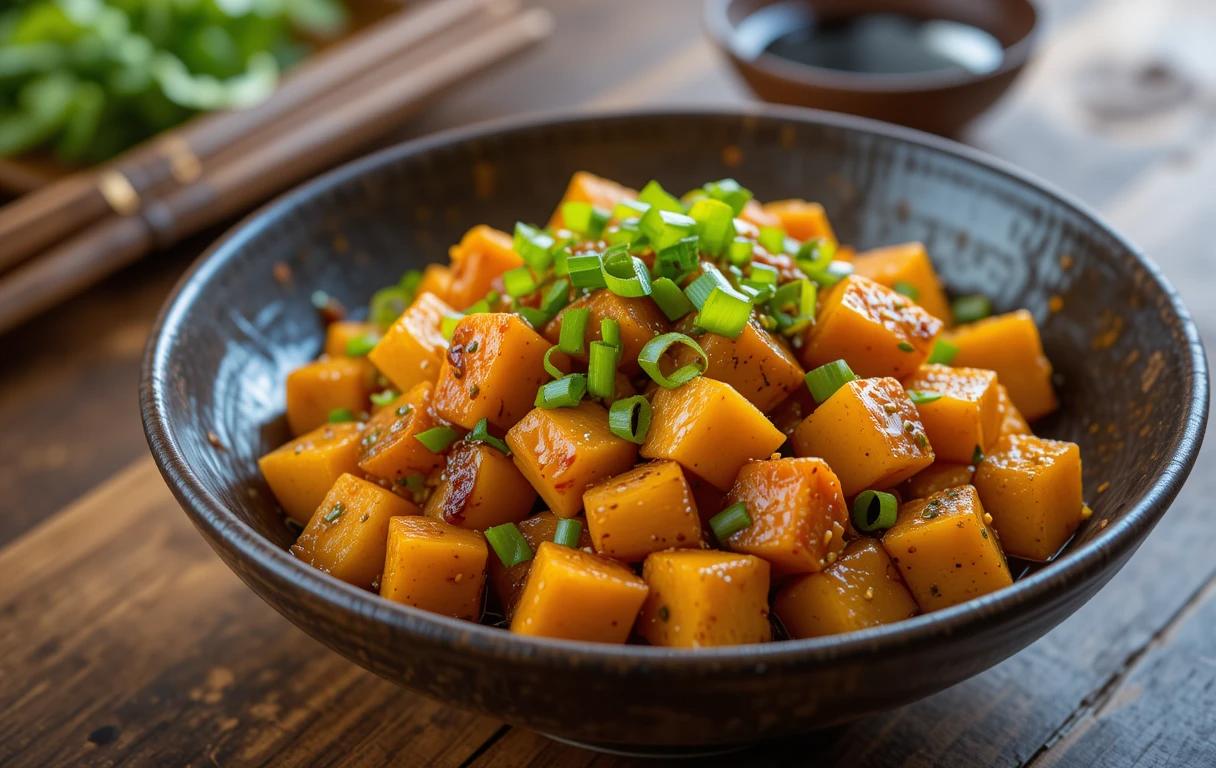Introduction to Chinese Squash Recipes with Kabocha for Vegans
Chinese cuisine often emphasizes harmony in flavors and textures, and squash is a popular ingredient thanks to its sweet, nutty flavor and versatility. One type of squash gaining prominence is kabocha squash, often referred to as Japanese pumpkin. This vibrant, deep green squash with orange flesh is rich in nutrients like beta-carotene, vitamin C, and fiber, making it an excellent addition to a vegan diet.
In Chinese recipes, kabocha squash is celebrated for its creamy texture and adaptability to both savory and sweet dishes. Its natural sweetness pairs well with the bold flavors of Chinese spices and condiments, offering endless possibilities for creating vegan-friendly dishes. Whether stir-fried, steamed, roasted, or made into soups, kabocha squash adds a delightful twist to traditional recipes.
This introduction will explore the use of kabocha squash in vegan Chinese cuisine, showcasing how it can replace animal-based ingredients while maintaining authentic flavors. Expect tips on pairing it with classic ingredients like soy sauce, garlic, ginger, and sesame oil, as well as incorporating other vegetables, tofu, or legumes to create balanced meals. From hearty soups to savory stir-fries and even desserts, Chinese-style kabocha recipes will inspire you to embrace this versatile squash in your plant-based cooking adventures.
Overview of Kabocha Squash and Its Role in Chinese Cuisine
Kabocha squash, also known as Japanese pumpkin, is a winter squash prized for its sweet, nutty flavor and velvety texture. It has a dark green, bumpy exterior and bright orange flesh that becomes tender and creamy when cooked. Native to Japan but embraced globally, kabocha is a staple ingredient in Asian cuisines, including Chinese cooking, where it plays a versatile and integral role.
Nutritional and Culinary Benefits
Kabocha squash is packed with nutrients, including beta-carotene, vitamin C, potassium, and dietary fiber. These properties make it a wholesome addition to Chinese dishes, aligning with the traditional emphasis on balancing nutrition and flavor. Its natural sweetness and creamy texture complement a wide range of spices and seasonings commonly used in Chinese cuisine.
Traditional and Modern Uses
In Chinese culinary traditions, squash has long been used in dishes such as soups, stews, and stir-fries. Kabocha, with its adaptability, has become a favored choice in modern Chinese kitchens. It is often used to:
- Enhance Soups and Congees: Its creamy texture and mild sweetness make it an excellent base for hearty soups, such as those featuring tofu, mushrooms, or mung beans.
- In Stir-Fries: Paired with aromatic ingredients like garlic, ginger, and soy sauce, kabocha brings a soft, comforting element to stir-fried dishes.
- As a Vegetarian Delight: Kabocha is perfect for creating vegan-friendly meals, replacing animal-based ingredients while maintaining a rich and satisfying flavor profile.
- In Desserts: Its natural sweetness is ideal for Chinese-style desserts like steamed cakes, sweet soups, or baked goods.
Cultural Significance
In Chinese cuisine, seasonal vegetables like kabocha squash are valued for their symbolic meanings. Squash represents abundance and nourishment, aligning with traditional Chinese values of health and prosperity. Incorporating kabocha in meals, especially during festivals or family gatherings, underscores these themes.
A Rising Star in Vegan Cuisine
With the growing popularity of plant-based diets, kabocha squash is gaining recognition for its ability to mimic the creamy richness of dairy in vegan recipes. Its versatility allows chefs to innovate, blending traditional Chinese techniques with modern dietary preferences.
In summary, kabocha squash is not only a nutritious and delicious ingredient but also a bridge between tradition and innovation in Chinese cuisine, offering endless opportunities to delight the palate in vegan and non-vegan dishes alike.
Importance of Vegan Cooking and Its Growing Popularity
Vegan cooking has emerged as a global culinary movement, driven by a growing awareness of health, environmental sustainability, and ethical considerations. This plant-based approach to food preparation excludes all animal products, including meat, dairy, and eggs, focusing instead on the richness of vegetables, fruits, grains, legumes, nuts, and seeds. Its importance lies in the numerous benefits it offers for individuals, communities, and the planet.
Health Benefits

One of the primary reasons for the popularity of vegan cooking is its significant health advantages. Studies have shown that a plant-based diet can:
- Promote Heart Health: Reducing cholesterol and saturated fat intake helps prevent cardiovascular diseases.
- Support Weight Management: Low-calorie density and high fiber content make vegan diets effective for maintaining a healthy weight.
- Reduce Chronic Disease Risk: A vegan diet is linked to lower risks of type 2 diabetes, certain cancers, and hypertension.
- Enhance Digestion: High levels of dietary fiber promote gut health and improve digestion.
Environmental Impact
The environmental footprint of animal agriculture is a growing concern, and vegan cooking offers a sustainable alternative:
- Reducing Greenhouse Gas Emissions: Plant-based diets significantly lower carbon emissions compared to diets that include animal products.
- Preserving Resources: Growing plants for food requires less land, water, and energy than raising livestock.
- Protecting Biodiversity: Reducing deforestation for grazing and feed crops helps maintain ecosystems and wildlife habitats.
Ethical Considerations
For many, vegan cooking aligns with ethical values of compassion and respect for animal life. By eliminating the use of animal products, vegan cooking reduces the demand for factory farming and the associated suffering of animals.
Cultural and Culinary Innovation
Vegan cooking is not just about eliminating certain foods—it’s about exploring a world of flavors, textures, and techniques. The rise of veganism has sparked creativity in cuisines worldwide:
- Global Influences: Incorporating plant-based staples from various cultures (e.g., tofu, lentils, jackfruit).
- New Ingredients and Techniques: Innovations like plant-based milks, cheeses, and meat substitutes make vegan dishes more accessible and appealing.
- Reviving Traditional Dishes: Many traditional cuisines, such as Indian, Mediterranean, and Asian, have inherently plant-based recipes that fit seamlessly into vegan cooking.
Growing Popularity
Veganism is no longer a niche lifestyle—it is becoming mainstream:
- Increased Awareness: Documentaries, books, and social media have made information about veganism widely accessible.
- Restaurant and Product Availability: Plant-based menus and products are now readily available in restaurants and supermarkets worldwide.
- Support from Influencers and Celebrities: Public figures advocating for veganism have played a role in normalizing and popularizing this lifestyle.
A Future-Forward Choice
As more people seek to make conscious food choices, vegan cooking represents a way to align personal health with global sustainability and ethical responsibility. Whether for a single meal or a lifelong commitment, vegan cooking is an important step toward a more compassionate and sustainable world.
Understanding Kabocha
What is Kabocha Squash?
Kabocha squash, often called Japanese pumpkin, is a winter squash known for its dark green, bumpy skin and vibrant orange flesh. It has a sweet, nutty flavor and a creamy texture when cooked, making it a favorite ingredient in both savory and sweet dishes. Originating from Japan, kabocha is now widely used in various cuisines due to its versatility and unique taste. Unlike some other squashes, its skin becomes tender when cooked, allowing it to be eaten along with the flesh, adding texture and nutrients to dishes.
Nutritional Benefits of Kabocha Squash
Kabocha squash is not only delicious but also packed with essential nutrients that support overall health:
- Rich in Beta-Carotene:
- Converts to vitamin A in the body, supporting eye health, immune function, and skin health.
- High in Vitamin C:
- Strengthens the immune system and acts as an antioxidant, reducing inflammation.
- Low in Calories:
- Despite its natural sweetness, kabocha is low in calories, making it a great choice for weight management.
- Good Source of Fiber:
- Aids digestion, promotes gut health, and helps maintain stable blood sugar levels.
- Contains Essential Minerals:
- Includes potassium, which regulates blood pressure, and small amounts of magnesium and iron for overall well-being.
- Rich in Antioxidants:
- Protects the body from free radical damage and reduces the risk of chronic diseases.
Why Kabocha is a Great Choice for Vegan Recipes
Kabocha squash stands out as a fantastic ingredient for vegan cooking due to its versatility, nutrition, and ability to elevate dishes:
- Creamy Texture:
- Its smooth, creamy texture mimics the richness of dairy in soups, sauces, and desserts, making it a great alternative for vegan recipes.
- Natural Sweetness:
- Adds depth of flavor without the need for added sugars, enhancing both savory and sweet dishes.
- Adaptability:
- Works well in various cooking methods, such as roasting, steaming, or pureeing, and pairs seamlessly with herbs, spices, and other plant-based ingredients.
- Nutrient Density:
- Provides essential nutrients that complement a plant-based diet, ensuring meals are both delicious and nutritious.
- Complements Vegan Staples:
- Pairs beautifully with tofu, legumes, grains, and leafy greens, allowing for endless recipe combinations.
- Accessible and Affordable:
- Widely available in markets and reasonably priced, kabocha is an economical ingredient for daily cooking.
In summary, kabocha squash is a powerhouse ingredient in vegan recipes, offering exceptional flavor, texture, and nutrition. Whether you’re crafting a comforting soup, a vibrant stir-fry, or a delightful dessert, kabocha brings both substance and satisfaction to plant-based meals.
Vegan Chinese Ingredients

Chinese cuisine offers a vast array of plant-based ingredients that are not only flavorful but also rich in nutrients. These ingredients form the backbone of vegan Chinese cooking, allowing for the creation of authentic, delicious, and satisfying meals without the use of animal products. Here’s an overview of key vegan Chinese ingredients:
Staple Grains and Starches
- Rice:
- Long-grain, short-grain, jasmine, or sticky rice are staples for dishes like fried rice, congee, or steamed rice bowls.
- Noodles:
- Wheat noodles, rice noodles, mung bean noodles (glass noodles), and buckwheat soba are versatile options for soups, stir-fries, and salads.
- Tofu Skin (Yuba):
- Made from soy milk, it has a chewy texture and is perfect for wrapping or as a protein source.
Proteins
- Tofu:
- Available in various forms (silken, firm, extra firm), tofu absorbs flavors well and is used in stir-fries, soups, and braised dishes.
- Tempeh:
- A fermented soybean product with a nutty flavor, used as a meat substitute in stir-fries or as a crispy topping.
- Seitan:
- A wheat gluten-based protein with a chewy texture, used to mimic meat in traditional recipes.
- Edamame:
- Fresh soybeans served steamed or incorporated into stir-fries and rice dishes.
Vegetables
- Leafy Greens:
- Bok choy, Chinese broccoli (gai lan), napa cabbage, and mustard greens are commonly stir-fried or steamed.
- Root Vegetables:
- Lotus root, taro, and daikon radish add crunch and earthy flavors to dishes.
- Squash and Gourds:
- Kabocha, bitter melon, and winter melon are often used in soups, stews, and stir-fries.
- Mushrooms:
- Shiitake, enoki, oyster, and wood ear mushrooms are prized for their umami flavor.
Condiments and Seasonings
- Soy Sauce:
- A staple for adding umami and depth to dishes. Use tamari for a gluten-free alternative.
- Sesame Oil:
- Adds a nutty aroma and flavor; typically used as a finishing oil.
- Hoisin Sauce:
- A sweet and savory sauce often used in marinades and stir-fry dishes.
- Chili Sauce and Oil:
- Ingredients like doubanjiang (fermented chili bean paste) and chili oil add heat and complexity.
- Vinegar:
- Black vinegar and rice vinegar provide acidity and balance to dishes.
- Fermented Ingredients:
- Fermented black beans and preserved vegetables (like mustard greens) enhance flavor depth.
Dried Ingredients
- Seaweed:
- Nori, kombu, and wakame add a briny flavor to soups and broths.
- Dried Mushrooms:
- Rehydrated dried mushrooms like shiitake intensify the umami profile of dishes.
- Dried Tofu Sticks:
- A chewy and protein-rich addition to soups and stir-fries.
Legumes and Nuts
- Black Beans:
- Often used in sauces or stir-fries for a savory kick.
- Peanuts and Cashews:
- Commonly used in stir-fries or as toppings for added crunch.
- Soybeans and Lentils:
- Serve as versatile protein sources in soups and stews.
Fruits
- Lychee and Longan:
- Sweet, juicy fruits often used in desserts or paired with savory dishes.
- Citrus:
- Oranges and tangerines add brightness and acidity to dishes.
Carbohydrate Alternatives
- Sweet Potatoes and Taro:
- Often steamed, fried, or mashed in traditional recipes.
- Rice Cakes:
- Chewy and dense, used in stir-fries or soups.
Herbs and Aromatics
- Garlic and Ginger:
- Essential for building flavor in almost all Chinese dishes.
- Green Onions and Chives:
- Add freshness and depth to recipes.
- Cilantro:
- Often used as a garnish for a bright, herbal note.
Sweeteners
- Rock Sugar:
- Used in soups, braises, and desserts for a subtle sweetness.
- Maltose Syrup:
- A traditional sweetener for glazes and desserts.
These ingredients, used creatively, enable vegan Chinese cooking to offer both authenticity and innovation, delivering bold flavors, satisfying textures, and nourishing meals.
Stir-Frying Techniques for Kabocha Squash
Stir-frying is a quintessential Chinese cooking method that is both quick and versatile. When it comes to kabocha squash, its naturally sweet and creamy texture makes it an excellent ingredient for stir-fried dishes. However, stir-frying kabocha requires a few specific techniques to achieve the perfect balance of tenderness and flavor without becoming overly mushy.
Preparation Tips
- Selecting the Kabocha:
- Choose a squash that is firm, heavy for its size, and free of blemishes.
- The skin is edible, so you can leave it on for added texture, but you may peel it if preferred.
- Cutting the Kabocha:
- Cut the squash in half, remove seeds, and slice into thin wedges or small cubes (about ¼ to ½ inch thick).
- Thin slices cook faster and are ideal for stir-frying.
- Par-Cooking (Optional):
- To ensure even cooking during stir-frying, steam or blanch the kabocha pieces for 2–3 minutes until slightly tender. This step prevents them from overcooking in the wok.
Key Ingredients for Stir-Frying
- Aromatics: Garlic, ginger, and green onions for a flavorful base.
- Sauces: Soy sauce, hoisin sauce, or oyster mushroom sauce (vegan) for umami depth.
- Seasonings: A pinch of salt, pepper, or chili flakes for balance and spice.
- Oil: Use high-smoke-point oils like peanut oil, vegetable oil, or sesame oil for added aroma.
Step-by-Step Stir-Frying Method

- Preheat the Wok:
- Heat a wok or large skillet over medium-high heat until hot. Add 1–2 tablespoons of oil and swirl to coat the surface evenly.
- Cook the Aromatics:
- Add minced garlic, ginger, and any other aromatics. Stir-fry for about 30 seconds until fragrant.
- Add the Kabocha:
- Increase the heat to high and add the sliced kabocha. Stir quickly to coat the pieces in the aromatic oil.
- Add Seasonings and Liquid:
- Season with a splash of soy sauce, a pinch of salt, and optional chili flakes. Add a few tablespoons of water or vegetable stock to create steam, helping the squash cook through while keeping it moist.
- Stir-Fry Until Tender:
- Stir continuously to prevent sticking, cooking for 5–7 minutes until the kabocha is tender but still holds its shape. Test with a fork to ensure it’s cooked through.
- Finish with Garnishes:
- Drizzle with a bit of sesame oil for a nutty aroma. Optionally, sprinkle chopped green onions or sesame seeds before serving.
Additional Tips for Success
- Avoid Overcrowding the Wok:
- Stir-fry in small batches to ensure even cooking and maintain high heat.
- Customize the Flavor:
- Add other vegetables like bell peppers, snap peas, or mushrooms for a colorful dish.
- Incorporate tofu or tempeh for added protein.
- Serve Immediately:
- Stir-fried kabocha is best enjoyed fresh and hot, paired with steamed rice or noodles.
Popular Variations
- Sweet and Spicy Kabocha:
- Add a touch of sugar and chili paste for a sweet-spicy kick.
- Garlic Soy Kabocha:
- Highlight garlic and soy sauce for a classic umami-rich dish.
- Kabocha with Black Bean Sauce:
- Use fermented black bean paste for a bold, savory flavor.
With these techniques, you can transform kabocha squash into a flavorful and satisfying stir-fried dish that’s perfect for a vegan Chinese-inspired meal.
Health Benefits: The Nutritional Profile of Kabocha and How It Supports a Vegan Diet
Kabocha squash, also known as Japanese pumpkin, is a nutrient-dense vegetable that provides a range of vitamins, minerals, and antioxidants essential for maintaining good health. Its nutritional profile makes it an excellent addition to a vegan diet, offering not only sustenance but also targeted support for common nutritional needs in plant-based eating.
Nutritional Profile of Kabocha Squash (Per 1 Cup, Cooked)
- Calories: ~40 kcal
- Carbohydrates: 10 g
- Protein: 1 g
- Fat: 0 g
- Fiber: 2.7 g
- Vitamin A: ~245% of the Daily Value (DV)
- Vitamin C: ~19% of the DV
- Potassium: ~8% of the DV
- Calcium: ~3% of the DV
- Iron: ~4% of the DV
- Beta-Carotene: High levels (converted to Vitamin A)
Key Health Benefits of Kabocha
- Rich in Vitamin A:
- Kabocha is an outstanding source of beta-carotene, which the body converts to vitamin A. This supports:
- Eye health, reducing the risk of age-related macular degeneration.
- Immune function by enhancing the body’s ability to fight infections.
- Healthy skin, promoting cell repair and rejuvenation.
- Kabocha is an outstanding source of beta-carotene, which the body converts to vitamin A. This supports:
- Boosts Immunity:
- With its high content of vitamin C, kabocha helps strengthen the immune system by stimulating white blood cell production and acting as a powerful antioxidant to reduce inflammation.
- Supports Digestive Health:
- The dietary fiber in kabocha aids digestion, prevents constipation, and supports a healthy gut microbiome, all of which are critical components of a balanced vegan diet.
- Promotes Heart Health:
- Low in fat and high in potassium, kabocha helps regulate blood pressure and reduces the risk of cardiovascular diseases. Its antioxidants also prevent oxidative stress, a factor in heart disease.
- Low-Calorie and Filling:
- Kabocha’s natural sweetness and low-calorie density make it a satisfying food choice for weight management without compromising taste or nutrition.
- Regulates Blood Sugar:
- The fiber in kabocha helps stabilize blood sugar levels, making it a good option for those looking to maintain steady energy levels throughout the day.
- Rich in Antioxidants:
- In addition to beta-carotene, kabocha contains other antioxidants that combat free radicals, reducing the risk of chronic diseases like cancer and diabetes.
- Mineral Support:
- Potassium aids in electrolyte balance and muscle function.
- Small amounts of calcium and iron contribute to bone strength and energy production, addressing common concerns in vegan diets.
How Kabocha Supports a Vegan Diet
- A Versatile, Nutrient-Dense Base:
- Kabocha can be the star ingredient in soups, stews, and purees, providing nutrients and a creamy texture without the need for dairy.
- A Great Source of Complex Carbohydrates:
- For vegans, kabocha serves as an excellent source of slow-digesting carbohydrates that provide long-lasting energy.
- Helps Meet Vitamin A Needs:
- Plant-based diets may sometimes fall short of preformed vitamin A (retinol). Kabocha’s beta-carotene content ensures sufficient intake for vegans.
- Naturally Dairy-Free Creaminess:
- Its creamy texture, when cooked, makes kabocha an ideal replacement for cream in recipes, supporting the creation of rich, satisfying dishes without animal products.
- Iron Absorption Aid:
- Vitamin C in kabocha enhances the absorption of non-heme iron from other plant-based foods, which is crucial for maintaining healthy iron levels in a vegan diet.
- Eco-Friendly and Sustainable:
- As a plant-based, seasonal vegetable, kabocha aligns with vegan principles of sustainability and environmental consciousness.
Incorporating kabocha squash into a vegan diet not only adds flavor and variety but also ensures a well-rounded intake of essential nutrients. Whether roasted, steamed, or pureed, kabocha offers a delicious and healthful way to enhance plant-based meals.
Serving Suggestions
How to Present Your Kabocha Dishes Like a Pro
- Use Contrasting Colors: Highlight kabocha’s vibrant orange color by pairing it with green vegetables like bok choy, snap peas, or broccoli.
- Layering and Garnishing: Present kabocha slices on a bed of steamed rice or noodles, topped with sesame seeds, green onions, or chili oil for a professional finish.
- Elegant Plating: Arrange kabocha wedges in a fan shape or stack cubes neatly in bowls to give your dish a structured and refined look.
- Traditional Serveware: Use bamboo steamers, ceramic bowls, or lacquered plates to add an authentic Chinese aesthetic.
- Drizzle with Sauce: A final drizzle of soy sauce, hoisin sauce, or sesame oil adds shine and enhances visual appeal.
Pairing Kabocha Recipes with Other Vegan Chinese Dishes
- Pair with Rice or Noodles: Serve stir-fried kabocha alongside fried rice or lo mein for a satisfying, balanced meal.
- Accompany with Dim Sum: Pair kabocha dumplings with steamed buns filled with mushrooms or tofu for a dim sum-inspired spread.
- Add a Side of Greens: Complement kabocha with stir-fried Chinese broccoli (gai lan) or garlic spinach for added freshness.
- Include a Hearty Soup: Pair roasted kabocha with hot and sour soup or a clear mushroom broth for a warming combo.
- Sweet and Savory Balance: Use kabocha in savory dishes and balance with a sweet dessert, like mango sticky rice or red bean pudding.
Frequently Asked Questions
Can Kabocha Squash Be Eaten Raw?
Yes, kabocha squash can be eaten raw, but it is not commonly done due to its dense and starchy texture. Thinly slicing or grating it for salads can work, but cooking brings out its sweetness and creamy texture, making it more enjoyable.
How Do You Store Kabocha Squash?
- Whole Squash: Store in a cool, dry place away from direct sunlight. It can last for 1–2 months if kept properly.
- Cut Squash: Wrap the cut pieces tightly in plastic wrap or place them in an airtight container. Refrigerate and use within 4–5 days.
- Cooked Squash: Store cooked kabocha in an airtight container in the fridge for up to 3 days or freeze for longer storage.
What Are Some Quick Kabocha Recipes for Beginners?
- Roasted Kabocha: Toss slices with oil, salt, and spices, then roast at 400°F (200°C) for 20–25 minutes.
- Kabocha Soup: Blend steamed kabocha with vegetable broth, garlic, and coconut milk for a creamy soup.
- Stir-Fried Kabocha: Sauté thin slices with garlic, ginger, soy sauce, and a splash of water for a quick stir-fry.
- Mashed Kabocha: Steam or boil kabocha and mash with a drizzle of sesame oil and a pinch of salt for a simple side dish.
12 Kabocha Squash Recipes to Give You a Break from Butternut
Conclusion
Why Kabocha Squash Deserves a Place in Your Vegan Chinese Recipe Book
Kabocha squash is a versatile, nutrient-packed ingredient that aligns perfectly with vegan cooking principles. Its natural sweetness, creamy texture, and adaptability to a variety of flavors make it a must-have for creating authentic and innovative Chinese dishes. Whether you’re making soups, stir-fries, or desserts, kabocha adds a unique flair and wholesome goodness to your meals.
Encouragement to Experiment and Enjoy Cooking Vegan Chinese Cuisine with Kabocha
Cooking with kabocha is an opportunity to explore the depth and richness of Chinese vegan cuisine. Its compatibility with traditional flavors and modern techniques allows you to create dishes that are both comforting and exciting. Don’t be afraid to experiment with different ingredients, seasonings, and presentations. By incorporating kabocha into your repertoire, you’re not just preparing meals—you’re celebrating the art of plant-based cooking. Embrace the journey, and enjoy the delicious possibilities!
Related Recipes
- “Tuna Tomato Sauce Pasta Recipe“: A tomato-based recipe showcasing another way to use tomatoes.
- “Baked Chicken Fettuccine Alfredo with Broccoli“: Another comforting dish that can be complemented with tomato-based sauces.
Ingredient-Focused Content
- “Lions Mane Mushroom Recipe“: Suggest using a tomato gravy as a flavorful addition for plant-based dishes.
Cooking Techniques and Enhancements
- “Mango Habanero Salsa“: Explore complementary uses of sauces and gravies for flavor diversity.
Storage and Reuse Tips
- “Sous Vide Recipes“: Recommend tomato gravy as a sauce for sous vide-cooked meats or vegetables.
- “Ocean Spray Cranberry Sauce Recipe“: Guide readers on making and storing sauces, including tomato gravy.

